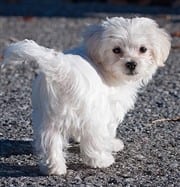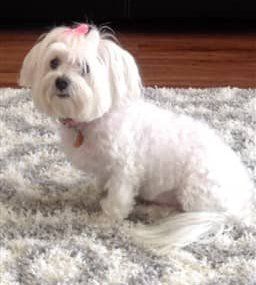Maltese Separation Anxiety
Overview
Leaving your puppy or dog home alone is never pleasant; however, it is so much worse when you know that your Maltese really struggles with this. Experiencing distress when alone is referred to as separation anxiety, and it can be both physically and emotionally draining for a puppy or dog.
In this section we will cover:
- Signs and common behaviors seen with this
- Steps you can take to help your Maltese better cope when home alone
Please note: PetMaltese is reader-supported. Some of the product suggestions on this page are affiliate links. As an Amazon Associate we earn from qualifying purchases. This is at no extra cost to you and helps us continue creating useful content.
Signs of Separation Anxiety
Each dog handles things a bit differently, some becoming sullen, some panicking, and some displaying behaviors in between these two extremes.
In general there is:
- Excessive barking
- Whining, crying, and/or clingy behavior before you leave
- Distressed or panicked behavior such as excessive pacing or jumping
- Destructive chewing
- Self chewing or biting (often at the paws, but almost always at one body area)
Additionally, some dogs do not have a quick recovery when owners come home. They can be frazzled for quite some time afterward.
Continual distress can take its toll on a puppy or dog; and you may notice a gradual downhill change in behavior and mood.
-min-251x335-1920w.jpg)
Spunky, photo courtesy of Eldri
How to Help a Maltese That Has Separation Anxiety
Having the Right Set-up
#1. Use a canine playpen.
There are several important reasons why most toy dogs with separation anxiety do best when within an appropriately sized pen.
1. Having free reign often makes things worse.
A tiny dog roaming inside a big house usually has increased feelings of isolation. And with a toy breed dog as small as the Maltese, even a gated off room is often too large.
2. Crates are too small.
Tiny pet crates are just as bad, but in the opposite way. These are terribly confining, and often increase a dog's stress level. They can be both physically and emotionally upsetting.
3. Pens create the pleasant feeling of having a 'den'.
All dogs, no matter the breed, are ruled by canine instinct. One of those very strong instincts is to seek what a 'den' offers. To a puppy or dog, a 'den' immediately signals safety and security.
4. A good-sized pen keeps all of your Maltese's necessities in one spot.
And this is key, since those items (which we will cover next) work to keep him calm and happy, and help erase feelings of loneliness. If a Maltese has a whole room to himself, those items can end up too far away from him for them to do their job.
Note:
You may be wondering about using gates to block off a section of a room; if you can do this while keeping roughly the same dimensions that a pen would provide this is another option for you.
For this, the IRIS 24'' 4-Panel Pet Playpen with Door
 work very well for most Maltese. This offers 8 square feet, is made of durable heavy-duty plastic, and has a door for easy in and out and one that can be kept open at times that you are there to supervise. There is also a larger 34" high option that offers 21 square feet that would be appropriate for larger Maltese that have proven themselves to be jumpers.
work very well for most Maltese. This offers 8 square feet, is made of durable heavy-duty plastic, and has a door for easy in and out and one that can be kept open at times that you are there to supervise. There is also a larger 34" high option that offers 21 square feet that would be appropriate for larger Maltese that have proven themselves to be jumpers.
# 2 Have a small yet quality canine bed.
Every Maltese should have his own bed, even if he normally rests on his owner's lap or takes naps on the floor. Here are a few points to keep in mind:
- Sleeping or resting on the floors can take its toll both on joints, and on the coat (most often noticeable on the elbows)
- A good bolstered bed will increase the 'den' attributes that we spoke of regarding the pen, that helps offer a feeling of safety and security.
- Since you will want your Maltese to love his bed, if he sleeps in your bed at night, he may have an intolerance to sleeping on his own bed during the day.
Bolstered beds are best for most Maltese puppies and dogs; only if a Maltese insists on being at floor level would you want to look into flat mattresses. Adults 6+ years should have an orthopedic bed.
#3. Place the pen in just the right spot. Most dogs do best when their pen is in a room that is normally used by the family. You'll find that a pen also works fantastic for when you are housebreaking a Maltese puppy, and for any times that you need your Maltese to be within a safe area (lots of guests over, etc.).
Typically, the living room is a good choice, as is the kitchen. You will also want to experiment with a window Vs a non-window view (if this is near sliders in the kitchen, etc.).
Lastly, in the winter check to make sure the area is not too close to cold drafts and hot heating that may be coming from vents, and in the summer checks for drafts from the AC.
#4. Have pee pads. Even for housebroken dogs, pee pads are always a good idea, because sometimes bathroom needs cannot wait until an owner gets home.
Dogs can only hold their needs so long. Therefore, whether your Maltese puppy is still learning or your older adult knows the rules, messes can be deposited onto the pads.
You do not really need your dog to be pee-pad trained for this. The reason is because his other items will be taking up real estate in the pen, and since dogs rarely soil their own belongings, pee and poo will most likely end up on the pads.
#5 Select the right toys.
Without careful thought to which type of toys your Maltese has when home alone, they may do very little good.
A few generic ones will often not be touched, and a mountain of inferior toys doesn't change that.
Toys need to be thought of as tools that meet specific purposes.
There are 2 types:
1. Those that provide entertainment.
Lonely dogs that may also feel frustrated, upset, or solemn need a couple of toys that prompt interaction.
Not only should they draw a dog in, but also keep him interested and happy. This can be done by offering motion activated toys that engage a dog each time they are pawed or nosed. For example, the Pet Qwerks Blinky Babble Ball
 lights up and emits attention-grabbing noises (a banjo playing, a whistle, a happy voice saying hello, etc.).
lights up and emits attention-grabbing noises (a banjo playing, a whistle, a happy voice saying hello, etc.).
2. Treat dispensing. Having one of these is often extremely helpful, because if you are gone for the day most likely you'll be away for at least one mealtime.
While you can always leave food in a bowl, this can be tipped over; but more importantly, a properly sized treat-release toy will also serve as a means to keep a puppy or dog occupied.
Snow, at 9 years old,
photo courtesy of Linda Martin
You may have noticed that many treat dispensing toys are sized much too large for the Maltese breed.
Fortunately, there is at least one that works well for most Maltese. The Busy Buddy Barnacle Toy Size Extra Small
 consists of 3 small balls, each that hold treats, so while the overall size is moderate, each molded globe is just about right.
consists of 3 small balls, each that hold treats, so while the overall size is moderate, each molded globe is just about right.
#6 Offer a companion toy.
No doubt, these are one of the best tools to fight separation anxiety.
The Smart Pet Love Snuggle Puppy
 is amazing. It is a good sized, sturdy yet soft stuffed animal. It sends out a calming, rhythmic heartbeat to mimic a living creature. In addition, it can also emit a comforting warmth (this is an optional setting). With this, your Maltese is no longer alone.
is amazing. It is a good sized, sturdy yet soft stuffed animal. It sends out a calming, rhythmic heartbeat to mimic a living creature. In addition, it can also emit a comforting warmth (this is an optional setting). With this, your Maltese is no longer alone.
#7 Play a loop of canine-specific calming music.
While you can leave on a TV or a radio, common problems with this are that you will have no control over which type of commercials come on (which are often irritatingly louder than shows), and while you may choose a great channel or station before you leave the house, programming may change as the day progresses.
A great option is to play music (MP3's, streaming, or CDs) that are specifically tailored for dogs. These can provide happy sounds and music that help create a really nice environment for a dog that home by himself.
An example of this is Through A Dog's Ear: Music To Calm Your Canine Companion
 which is available as unlimited streaming, a CD, or an MP3.
which is available as unlimited streaming, a CD, or an MP3.
More Helpful Tips
Once you know that you have created the perfect set-up for your Maltese, these are some additional tips.
1) When you are home, leave the door open to your Maltese's pen.
Keep some favorite toys there, and encourage him to curl up on his bed if he seems to want a nap.
The playpen should be accessible at all times, not just when you are away.
2) Before you leave, plan for plenty of time. You will want to take your Maltese out for bathroom needs without having to rush.
A good 20-minute (or up to 30-minute) walk in the morning is ideal, as this will allow a puppy or dog to stretch their muscles after a night's sleep and can somewhat tire a dog out.
You will also want there to be enough time so that you can place your Maltese in his area a good 20 minutes before you leave.
3) When you are leaving, have your goodbyes and hugs already done. Doing this right before you exit can induce some panic.
4) When you arrive back home, do not rush over to your Maltese with gushing words or attention. This can reinforce the notion that your absence was terrible and that your arrival back was a miracle.
Try to play it cool for about 5 minutes; check your mail, get a drink of water, casually walk around without making eye contact. And then, open the pen door and lather your Maltese with love.
You May Also Like:

Age specific feeding guidelines, how much Maltese typically eat, and helpful tips for choosing the best food for optimal health.

Keep your Maltese as healthy as can be by having him receive daily exercise all year round.
Spotlight Article
Tips for keeping a Maltese snowy white, with good skin and coat health.
Are you a Member yet?
Sign up for free
in order to receive a friendly notice when new pages are added to the site.

-min-450x169-1920w.jpg)

-min-256x335-1920w.jpg)